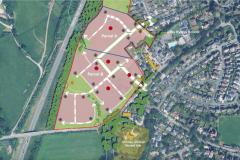A cobalt mine, abandoned in the early 19th century, has been discovered at Alderley Edge revealing a 'time capsule' of personal objects and equipment the workers left behind.
There has been mining activity at Alderley Edge since pre-historic times. Now owned by the National Trust the mines have been leased since the 1970s to the Derbyshire Caving Club, whose members maintain access and search for areas of mining that have been closed for centuries.
The latest mine to be discovered is believed to have been abandoned around 1810, and it is rare to find one in such pristine condition. Leather shoes, clay pipes, a metal button from a jacket, along with inscriptions written in candle soot, and mine machinery, were among the objects that were found.
Also uncovered was a clay bowl that had been buried in a wall, a practice that may have been followed by superstitious miners as an offering of thanks for a good vein of mineral. Other discoveries include clearly defined fingerprints in clay used to hold candles, and the imprint of corduroy from a worker's clothing where he leaned against a wall.
Among the larger abandoned items was a windlass, a piece of equipment used to shift large weights or quantities of raw materials. This is the first time such a piece has been uncovered at Alderley Edge.
Derbyshire Caving Club first made the discovery of the mine in autumn 2021 and has been researching it since. However access was not easy down a long mine shaft and a complex network of tunnels.
Ed Coghlan of the Derbyshire Caving Club explained: "In the time the Club has been active here, we have explored a number of disused historic mines and made some significant discoveries. But many mines have been filled in with rubble over the years or with sand washed into them by heavy rainfalls or they have been accessible in some form since they were abandoned, so anything of interest had been removed.
"To find a mine in pristine condition, together with such personal objects and inscriptions, is rare. It is a compelling window into the past and to the last day when the mine workers stopped their activities."
Ed continued: "One of the objects which we had not unearthed in this area before, was the windlass. This was an important piece of mining equipment which we would have expected the workers to have taken with them for use at another mine. It does suggest they were told without much warning to collect their tools and move on, which is not surprising once the cobalt was exhausted, since each day there was a day paying wages.
"We are also intrigued by the initials 'WS' with the date '20th Aug 1810' that we found written in candle soot in part of the mine, Who was he and what is the significance of the date? We found other more basic initials and numbers in what we believe were the 'cribs' or rest areas, as if someone had been learning and practicing their writing. But the 'WS' is stylishly written, with quite a flourish. Our research so far has not identified who this could be, Was it just an individual wanting to say, 'I was here', or from a visit by a mine manager or estate owner, or could it have been to indicate the last day this mine was in use?"
Jamie Lund, National Trust archaeologist said: "This discovery is helping us understand a less well-known chapter in the story of mining at Alderley Edge, which has been explored and exploited for 4000 years.
"We are passionate about giving people the chance to explore our industrial heritage and the Caving Club conducts tours of some of the more accessible mines that have been discovered at Alderley Edge. But sometimes locations with impractical access mean we need to find other ways to bring the place to life for visitors. Virtual access is a great way anyone can navigate their way around the mine from the comfort of their armchair and imagine themselves in the boots of the men who worked there.
"The objects found in the mine have been photographed and catalogued and left where they were found, to remain in the underground conditions which have preserved them. It leaves the mine as a time capsule, protecting a place that was once a hive of activity for future generations to explore and enjoy."










